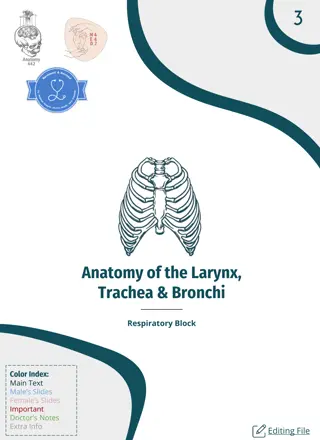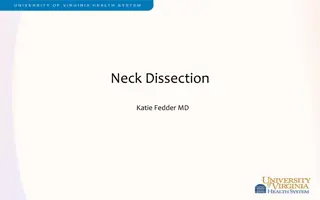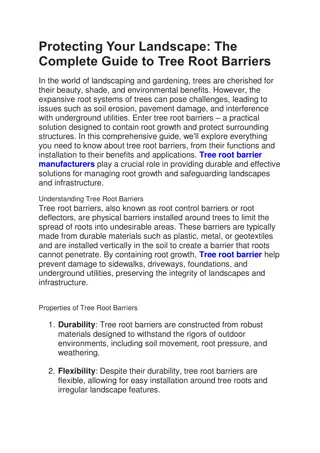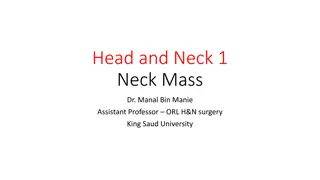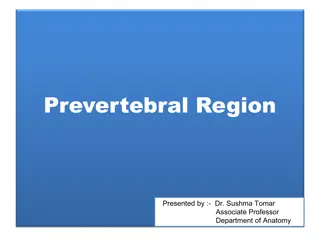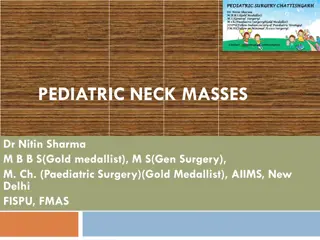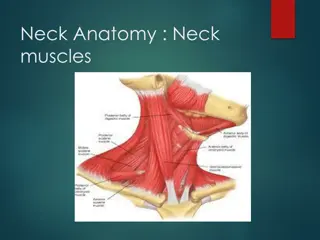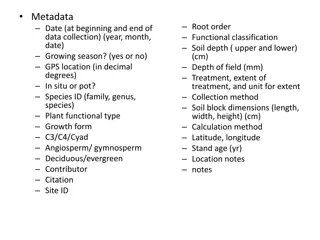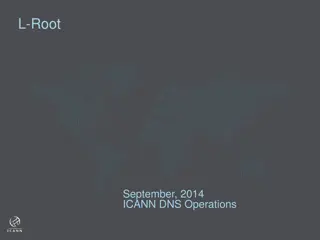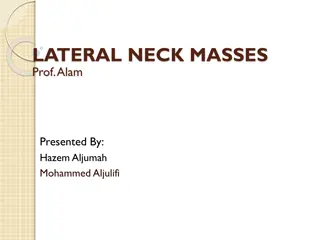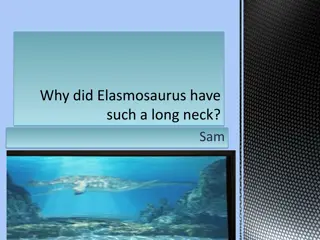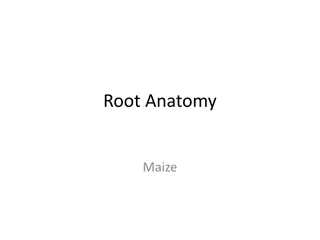Anatomy of Paravertebral Region and Root of Neck
This informative content presents the paravertebral region and the muscles of the neck, including the scalene muscles (posterior, medius, and anterior). It covers the origin, insertion, nerve supply, and actions of these muscles, providing a clear understanding of their functions. Additionally, it discusses the relations of the scalenus anterior muscle with nearby nerves, arteries, veins, and muscles, serving as a useful guide for studying the anatomy of the neck region.
Download Presentation

Please find below an Image/Link to download the presentation.
The content on the website is provided AS IS for your information and personal use only. It may not be sold, licensed, or shared on other websites without obtaining consent from the author.If you encounter any issues during the download, it is possible that the publisher has removed the file from their server.
You are allowed to download the files provided on this website for personal or commercial use, subject to the condition that they are used lawfully. All files are the property of their respective owners.
The content on the website is provided AS IS for your information and personal use only. It may not be sold, licensed, or shared on other websites without obtaining consent from the author.
E N D
Presentation Transcript
Paravertebral Region & Root Of Neck Presented by :- Dr. Sushma Tomar Associate Professor Department of Anatomy
PARAVERTEBRAL (Lateral Vertebral )MUSCLES PARAVERTEBRAL (Lateral Vertebral )MUSCLES o Extend obliquely from transverse processes of cervical vertebrae to the upper two ribs. o Lie under cover of sternocleidomastoid. o Covered by prevertebral layer of deep cervical fascia. o Consists of:- Scalenus posterior. Scalenus medius. Scalenus anterior.
Scalenus Scalenus Posterior Posterior Smallest and most deeply situated muscle in this group. ORIGIN- Posterior tubercles of the transverse processes of C4, C5, and C6 vertebrae. INSERTION- Outer surface of the 2nd rib, behind the tubercle for Serratus anterior. NERVE SUPPLY- Anterior primary rami of lower three cervical (C6, C7, and C8) spinal nerves. ACTIONS- Bends the cervical vertebral column to the same side (when the 2nd rib is fixed). Elevates the 2nd rib (when upper attachment is fixed).
Scalenus Scalenus Medius Medius ORIGIN- Posterior tubercles and costo-transverse bars of the transverse processes of C2- C6 vertebrae. INSERTION- Upper surface of the 1st rib, between the tubercle of the rib and groove for subclavian artery. NERVE SUPPLY- Anterior primary rami of C3-C8 spinal nerves. ACTIONS- Bends the cervical vertebral column to the same side (when the 1st rib is fixed). Elevates the 1st rib (when upper attachment is fixed)- accessory muscle of respiration.
Scalenus Scalenus Anterior Anterior Key muscle at the root of the neck. Most superficial and lies deep to Sternocleidomastoid muscle. It is a useful surgical landmark . ORIGIN- Anterior tubercles of the transverse processes of all typical cervical (C3- C6) vertebrae. INSERTION- Scalene tubercle on inner border of the 1st rib. Ridge on the upper surface of 1st rib separating the groove for subclavian artery posteriorly and groove for subclavian vein anteriorly.
Scalenus Scalenus Anterior Anterior contd contd NERVE SUPPLY- Anterior primary rami of C4, C5, and C6 spinal nerves. ACTIONS- Flexion of cervical part of vertebral column. Elevates the 1st rib-accessory muscle of respiration.
Relations of Relations of Scalenus Scalenus Anterior Anterior ANTERIOR- One nerve- 1. Phrenic Nerve. Two arteries- 1. Suprascapular artery. 2. Transverse cervical artery. Two veins- 1. Anterior jugular vein. 2. Subclavian vein. Two muscles- 1. Inferior belly of omohyoid. 2. Clavicular head of Sternocleidomastoid Carotid sheath. Clavicle bone.
Relations of Relations of Scalenus Scalenus Anterior Anterior contd contd POSTERIOR- Roots of brachial plexus. 2nd part of Subclavian artery. Scalenus medius muscle. Cervical pleura. Suprapleural membrane.
Scalene Triangle Scalene Triangle LOCATION- Above the first rib between Scalenus anterior and Scalenus medius muscle. CONTENTS- Trunks of brachial plexus. Subclavian artery.
Cervical Rib Cervical Rib Costal elements of 7th cervical vertebra undergo abnormal development and form cervical rib. Cervical rib arises from anterior tubercle of transverse process of 7th cervical vertebra. Occurs in less than 0.5% of population. Cervical rib may have free anterior end, may be connected to the 1st rib by a fibrous band or may articulate with the 1st rib.
Cervical Rib Cervical Rib contd contd Complete cervical rib passes laterally and forward between the Scalenus anterior and Scalenus medius muscles and joins with the first rib close to the insertion of scalenus anterior. More often it is unilateral. More frequent on the right side. Lower trunk of brachial plexus arches over the cervical rib.
Scalene Syndrome Scalene Syndrome Occurs due to compression of lower trunk of brachial plexus (C8 and T1) and Subclavian artery in the scalene triangle. ETIOLOGY- Cervical rib. Spasm of scalene muscles. CLINICAL PRESENTATION- Due to compression on lower trunk of brachial plexus: Sensory loss of medial one and half fingers of the hand and part of forearm. Tingling sensation and numbness along the inner border of forearm and hand. Progressive paresis and wasting of hypothenar muscles of the hand. Due to occlusion of Subclavian artery: Ischemic pain and absence of radial pulse
Scalene Syndrome Scalene Syndrome contd contd Compression of Subclavian artery may result in an aneurysm, which is a potential source of emboli to the hand. Emboli may cause gangrene of the finger tips. LOCAL COMPLICATIONS- Tender supraclavicular lump which is bony hard and fixed.
Scalenovertebral Scalenovertebral Triangle OR Triangle of Vertebral Artery Triangle OR Triangle of Vertebral Artery A deeply placed triangular space at the root of the neck. BOUNDARIES- Medial- Inferior oblique part of Longus colli. Lateral- Medial border of Scalenus anterior. Apex- Transverse process of C6 vertebra. Base- 1st part of subclavian artery. .
Boundaries of Boundaries of Scalenovertebral Scalenovertebral Triangle Triangle contd contd Floor- 1. Transverse process of C7 vertebra. 2. Ventral ramus of C8 spinal nerve. Neck of 1st rib. 3. 4. Cupola of cervical pleura. Roof- Carotid sheath
SCALENOVERTEBRAL TRIANGLE CONTD SCALENOVERTEBRAL TRIANGLE CONTD CONTENTS- 1st part of vertebral artery. Thyrocervical trunk. Inferior thyroid artery. Sympathetic chain with stellate ganglion. Ansa subclavia.





